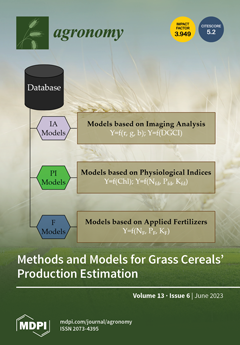In irrigated agriculture, the combination of multiple regulation measures is an effective method to improve saline soil and promote crop growth. Magnetized ionized water irrigation is considered a promising irrigation water activation technique, while the use of
Bacillus subtilis for soil amelioration is environmentally friendly. In this study, magnetized ionized water irrigation and
B. subtilis were used to promote cotton growth under film-mulched drip irrigation (FMDI) in saline soil. A two-year field experiment was conducted to investigate the effects of differing
B. subtilis amounts under two irrigation water types (non-magnetized-ionized water (NMIW) and magnetized ionized water (MIW)) on the growth (plant height, leaf area index, shoot dry matter and chlorophyll content) and the yield of cotton, as well as the soil water content, salts accumulation, water use efficiency (WUE) and irrigation water use efficiency (IWUE) under FMDI in a saline soil in southern Xinjiang. Five amounts of
B. subtilis (0, 15, 30, 45 and 60 kg ha
−1) under NMIW (designated as B0, B1, B2, B3 and B4) and MIW (designated as M, MB1, MB2, MB3 and MB4) were applied to the field experiments. The results showed that MIW and
B. subtilis increased soil water content and reduced salts accumulation in the 0–40 cm soil layers compared with B0. Moreover, the two measures significantly (
p < 0.01) increased cotton plant height, leaf area index, shoot dry matter and chlorophyll content compared with B0. Seed cotton yield, WUE and IWUE were also observed to significantly increase (
p < 0.05). Compared with the NMIW treatments, the MIW treatments increased seed cotton yield by 2.1–12.2%, increased WUE by 0.2–9.0%, and increased IWUE by 2.1–12.2%. Under MIW, with the
B. subtilis amount as an independent variable, quadratic function relationships with seed cotton yield, WUE and IWUE were established. By taking the first derivative of the quadratic function, the highest seed cotton yield, WUE and IWUE were obtained with the
B. subtilis amounts of 51.8, 55.0 and 51.4 kg ha
−1, respectively. Based on comprehensive consideration of seed cotton yield, WUE, IWUE and salts accumulation in soil, 51.4 kg ha
−1 of
B. subtilis under MIW treatment is recommended for cotton cultivated under FMDI in a saline soil of southern Xinjiang, China.
Full article





